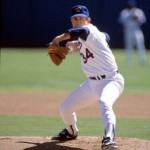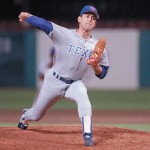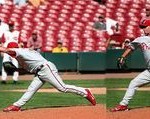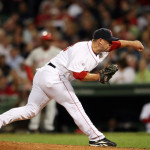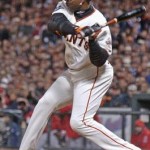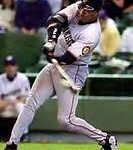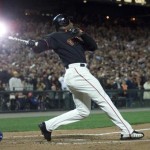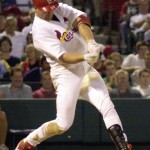If a baseball player wants to be the best batter that he can possibly be, what can he realistically expect from his absolute, best efforts? The best possible batting average is 1.000. Is it realistic for anyone to think he can sustain a 1.000 batting average over the course of a season, or a career? “Only in one’s dreams,” might be an appropriate reaction to such an improbable quest! Or, maybe a player had participated in a single game (perhaps the last game of a season) and by some good fortune was able to go 1 for 1, 2 for 2, or 3 for 3, etc., and then by some other less fortuitous circumstance had his baseball career terminated inexplicably. But that set of circumstances would not qualify even the most illustrious of natural prospects to embody the emblem of “Perfection.”
Since hitting a baseball effectively is indeed the most difficult task in all sporting activities, it is most unlikely (more like “impossible”) that any human being would be so proficient as to make flawless contact with his bat to the ball every time he took a swing. If it is possible for an extraordinarily proficient basketball “free-throw” shooter to shoot a thousand “free-throws” in a row, why is it not possible for a batter to go through a whole season (500 or 600 at-bats) without making an “Out”?
It is even unlikely (with the “law of averages” governing human events) that any batter could play an entire season without getting a hit; but it is at least 3 ½ times easier to accomplish that ignominious feat than to go without an out. If a batter deliberately tried to miss the ball, he could easily attain a 1.000-proficiency rating. Why? Because there would be less margin for error to be eliminated in accomplishing that feat!
A baseball has a 9-inch circumference. A batter would have no difficulty deliberately swinging his bat into an area that would surely avoid striking any 2.86 inch diameter of the pitched ball. His margin for error would be miniscule, taking into consideration all the places he could swing the bat to avoid the ball (in or out of the strike zone). The batter would have only one factor to consider — swing as far away from the ball as possible. He would need no pre-eminent sense of flawless technique or principle to accomplish his goal of “not hitting the ball.” He could establish no recommended stability of stance or acute visual capacity. (However, he might take some minor precaution for preventing his body from being struck by an errant pitch.)
Ted Williams said it best for all of us who have ever played the game of Baseball, as well as participated in other forms of athletics, “hitting a baseball is the single-most difficult thing to do in all of sports.” No other individual sport-skill encompasses the variety of challenging variables that a batter has to “put in order” to be a proficient “hitter.” Physical strength, flexibility, quickness, and timing, as well as the mental attributes of courage, confidence, determination, fortitude, are characteristically ascribed to even the least skilled professional who “stands-in” against a 95 mph fastball, or 85+ slider. When you add in all the off-speed multiples, you wonder why the Defense Department doesn’t make “Batting 999” a pre-requisite for the highest combat-training courses.
In all walks of Life, from a professional baseball player to a rock musician, a respectable accomplishment cannot be ultimately gained until after the process of trial and error has been satisfactorily consummated by means of a finished high-quality product. Until that has happened, one can assume that, in all of these life-challenges, the margins of error that seem so naturally retardant to proper development have not been reduced sufficiently to produce a genuinely finished product.
The principle of Batting is the scientific application of body-mechanics, based on the understanding of factors that influence the effect of the ball that comes from the throw of the pitcher. The batter, in the batter’s box, is standing a little more than 60 feet from the pitcher, on a plane almost 1 foot below the level of the “pitching-rubber.”
An intelligent person must realize that any ball thrown from a height range of 5 to 7 feet would have to follow a descending line or arc, in order to enter the batter’s strike zone. Therefore, any batter whose notion of proper hitting technique includes the idea that a downward swinging bat can effectively strike a downward moving ball with the least margin of error does not understand the statistical improbability of such folly. Such is the trademark of the .250 or under hitter.
Since “hitting a baseball is the single-most difficult thing to do in all of Sports,” as proclaimed by Mister Ted Williams, a most credible artisan of professional bats-man-ship, (and a fact fully attested to by countless other athletes, whose superiority in their own realms of athletic endeavor validate this otherwise presumptuous claim), it stands to reason that optimal batting proficiency should be afforded to no less than a dedicated student of the “art”. Art is the visible nature of things, the outward expression whose essence is comprehended by thought, not sense.
. The “Art” of hitting a baseball should be more than a physical exercise, by a well-conditioned athlete, to demonstrate quick reflexes in a random response to the various stimuli presented by a pitcher and a speeding round projectile. Rather, it is a calculated artistic display of functional expediency, by a dedicated aspirant to highest achievement, which incorporates the physical, mental, and spiritual components of human endeavor into a masterful exhibition of batting excellence.
The conscious coordinated effort of mind and body to provide maximum power and efficiency to propel the 5 ounce, 9 inch “spheroid” in a straight line in the general direction from which it was delivered (within a hitting range of 90 degrees) could verify a scientific component to masterful batting. Science is the invisible structure underlying the nature of things, whose harmony is determined by the precision of its Principle.
Batting proficiency could be defined further in the context of describing the ideal hitter —“he is one whose bat most consistently contacts the ball in a manner that facilitates a straight and ascending “line-drive” (To hit the ball in any other manner would be to miss-hit it, and therefore denigrate any artistic and scientific confluence).
There is adequate evidence to indicate that many or most good artists (of which athletes are included) have a “natural” propensity toward the artisanship in which they are engaged. But their optimal level of proficiency is most often derived from the degree to which they accumulate enhanced understanding by means of scientific examination of all aspects of their chosen profession. (Both Leonardo Da Vinci and Michaelangelo established their masterful artisanship by such practice.) Therefore, hitting a baseball most effectively would have to be construed as both an Art and a Science.
In professional Baseball, to be the best hitter you can be, you must apply science to your natural artistry or you will never achieve mastery over the elements that have superimposed a phenomenal limitation upon the highest expectations of all erstwhile protagonists in our nation’s unique Life-enthralling pastime. Physical attributions alone are typically found wanting when those are matched against the mental components of the experienced technicians of overpowering or magical mounds-man-ship.
Those outstanding physical athletes who do make it to the “Show,” but languish in obscure mediocrity, are typically the very prospects who could become stellar bats-men if they would engage a scientific examination conducive to complementing their artistic predisposition. And they who are performing at the prevailing “high” standard of Major-League batting proficiency could be setting new and higher criteria, if a more pronounced attentiveness to scientific inquiry were investigated for their optimal development.
The following is a list of components to consider for optimal batting efficiency, as well as their corresponding, obvious faults to be eliminated or at least diminished:
- Pitcher’s mound is about a foot above the level of home plate—swinging down at a ball moving downward is counter-productive (to say the least)
- Make Pitcher work harder: create a small strike-zone—standing tall is to the batter’s disadvantage
- A power base always starts with a low center of gravity, from which a stride is unnecessary—high stance, and stride reduce power and vision
- Stationary head secures optimal viewing—stride moves head, eyes
- Rotary motion of hips and shoulders by proper functioning of legs supplies power and secures vision—pushing from back foot and leg creates problems
- Hips and shoulders power the bat to ball—not the arms and hands
There is enough practical evidence to preclude any possibility that someone could actually attain the status of Perfection in batting. However, is it not reasonable to assume that current standards for excellence, in the department of batting, could be significantly advanced, were it not for the arrogant or narrow-minded presumption that nothing more can be done by scientifically reducing or eliminating all margins for technical error?

